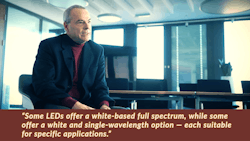Vertical farming should capitalize on full-spectrum LEDs (MAGAZINE)
A recent United Nations (UN) climate report made for uncomfortable reading. The widely reproduced headline was “a code red for humanity” — an unambiguous warning that rang alarm bells in the minds of many observers across Europe. With a renewed urgency, every industry must now focus on cutting carbon emissions before it’s too late.
The LED industry can make an immediate impact through the sectors which it serves, including in solid-state lighting (SSL) across many applications. One example with enormous potential for reduced carbon emissions through reduced energy consumption is within agriculture, where LEDs are ideally constructed to provide light in vertical farms. Vertical farming is an extremely sustainable food production method, important as industrialization and climate change continue to reduce soil fertility and shrink available land for conventional farming.
This is great news for our planet, and for LEDs. While artificial light sources like metal halide, high-pressure sodium, and fluorescent lamps tend to be less efficient, have shorter lifespans, and are limited in wavelength control, LEDs are energy-efficient, long-lasting, and more easily controlled with regard to spectra, uniformity, and brightness.
One effective strategy in LED cultivation has been to select the optimal spectra for a specific crop or cultivar — wavelengths that offer both high quality and energy efficiency. Photosynthetic responses from various plants are generally similar in terms of considering quantum yield, while a morphological response is more species- and cultivar-specific.
Studies show red light and blue light tend to fit with the absorption peak of chlorophylls involved in photosynthesis. Red radiation is best for driving photosynthesis based on quantum yield. However, blue light nurtures the vegetative and flowering stages of plant growth.
Until now, these functions have made for a conventionally narrow horticulture spectrum by simply employing a combination of blue and red lights — an approach widely used in Europe.
While the use of red, blue (and to an extent, green) light is common to encourage growth, Samsung trials of different LED types showed surprising results when using white-based, full-spectrum LED light to grow common leafy green vegetables and herbs.
As part of an experiment, our researchers grew lettuce and basil in four separate containers, each featuring different light conditions. Three of the containers used white-LED-based full spectra, and one used narrow spectra by employing only blue and red LEDs. The photoperiod of all the treatments was 16 hours per day and photosynthetic photon flux density (PPFD) was set at 160 μmol⋅m2/s.
The results of the individual growth chambers showed that the broad-spectra treatments clearly outperformed narrow ones, implying the addition of other colors, like green and yellow, or full-spectrum lights, produce a stronger yield than dual-colored blue and red lights. Moreover, the testing showed that green light reaches the bottom layer of leaves and branches due to its high transmittance, while also contributing to signaling information that reverses the defense mechanism of UV blue light.
Red light (630–660 nm) has proven essential for the growth of stems and the expansion of leaves. Blue light (400–520 nm) needs to be carefully mixed with light in other spectra; otherwise, overexposure may stunt the growth of certain plants. Green light (500–600 nm) penetrates through thick top canopies to support the leaves in the lower canopy, and far-red light (720–740 nm) also passes through dense upper canopies to support the growth of leaves located lower on the plants. In addition, exposure to infrared wavelengths reduces the time a plant needs to flower.
Tailoring this range of light is almost impossible through purely natural methods due to climate and environmental factors in traditional daylight-driven growing operations. However, the use of artificial light created by LEDs allows vertical farmers to control exactly what these plants are exposed to, creating the perfect growing environment.
It’s important to note that not all LEDs are created equal, and some are more suited to certain types of crops than others. Some LEDs offer a white-based full spectrum, while some offer a white and single-wavelength option — each suitable for specific applications. Energy efficiency is important across the board. Vertical farmers should look out for a photosynthetic photon efficacy of around 2.74 μmol/J to get the most out of their investment (delivering the most effective amount of photons to plants without wasting considerable energy), while dramatically extending non-yellowing lifetime and offering better PPFD uniformity.
Get to know our expert
DAVID BARNBY is head of LED business EMEA for Samsung Electronics. He has long worked in technology industries in sales and marketing leadership roles, spanning such markets as electronic components and integrated circuits to LEDs and solid-state lighting end products.





